¿Qué es Prebid? | Todo lo que los editores deben saber
Prebid es un wrapper de header bidding de código abierto al que puede acceder cualquier persona y que utilizan muchos editores en la actualidad.
Con la introducción de prebid.js en 2015, todo cambió. Aceleró la adopción a gran escala de la tecnología header bidding, introdujo un estándar industrial claro y simplificó la configuración.
En este artículo, aprenderá qué es prebid, cómo funciona, cómo implementarlo y qué beneficios ofrece.
¿Qué es Prebid?
Prebid permite a los editores conectarse con miles de socios de demanda a través de su extensa biblioteca de adaptadores eficientes, lo que permite realizar ofertas en el inventario de anuncios disponible del editor. inventario publicitario.
Esta característica, junto con la flexibilidad de personalización del software de código abierto, da como resultado la solución ideal de header bidding que los editores pueden modificar para satisfacer sus necesidades.
Prebid.js es actualmente el wrapper header bidding más popular en Internet.
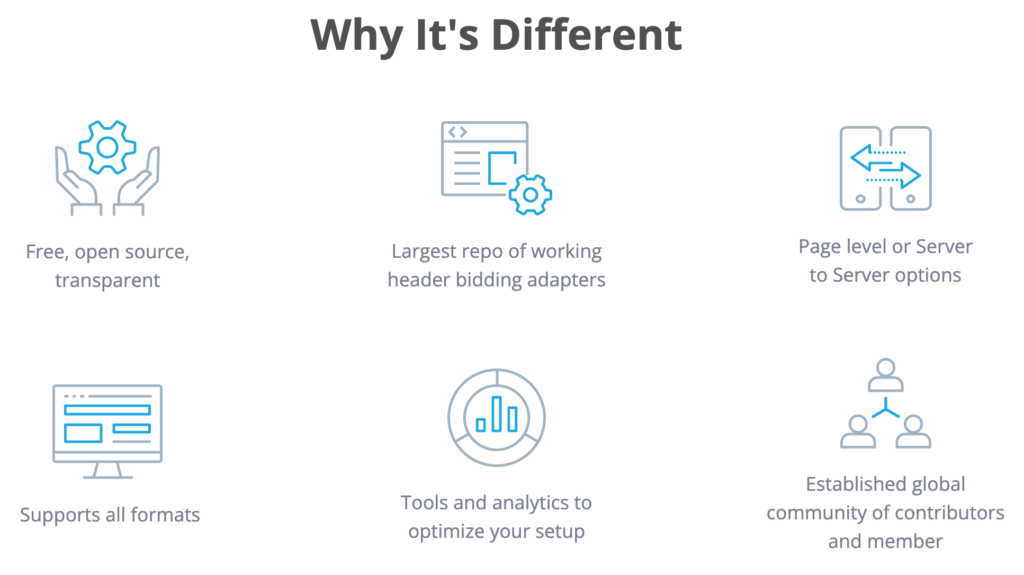
Fuente: Prebid
Prebid.org es una organización creada para garantizar y promover un header bidding justo, transparente y eficaz en todo el sector. Está disponible para todas las empresas del ecosistema programático, incluidos editores, tecnología publicitaria y otros.
¿Qué es Prebid.js?
Prebid.js, también conocido como wrapper prebid, es una solución de código abierto que simplifica la implementación de header bidding en los sitios web y aplicaciones móviles de los editores.
Antes de prebid, los editores debían tener un equipo técnico para crear header bidding. Sin embargo, prebid.js puso a disposición de todos una solución con una configuración básica relativamente rápida y de bajo costo.
Prebid.js proporciona la colección más extensa de adaptadores activos mediante el desarrollo de una capa tecnológica básica y abierta, sobre la cual las empresas pueden construir su código.
¿Qué es un prebid adapter?
Según Prebid, “A alto nivel, un bidder adapter es responsable de:
- Crear las solicitudes de puja para el servidor del postor.
- Analizar y registrar las respuestas de puja».
Si eres un editor y quieres implementar header bidding e incluir los mejores SSPs como OpenX, necesitarías un adapter para cada socio.
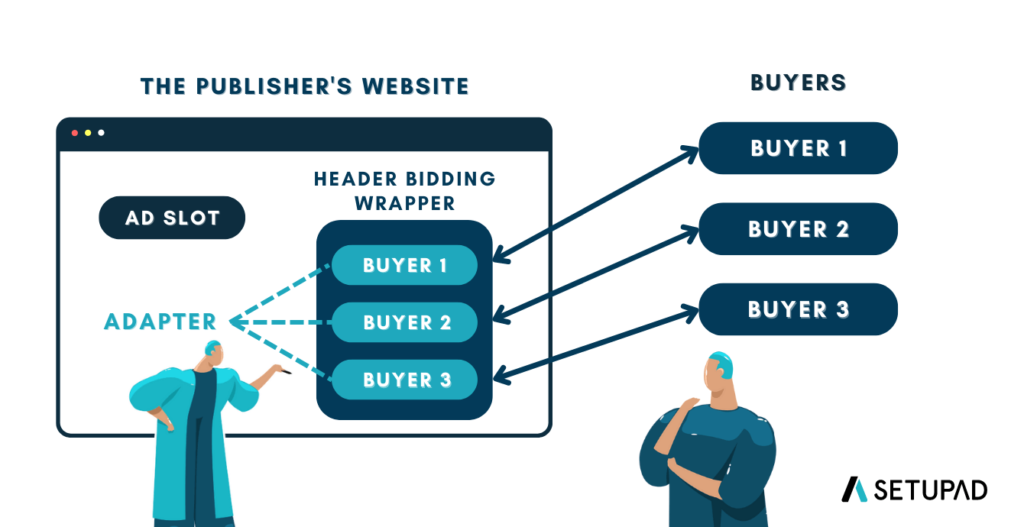
En pocas palabras, el adapter es necesario para acceder a la demanda de SSP. Header bidding wrapper sirven de contenedor para estos adaptadores, pero un wrapper por sí solo no puede integrar a los socios de la demanda.
Esta terapia, además prebid adapter crean las solicitudes de ofertas. para el servidor del postor y analizan las respuestas de la puja (valor de la oferta y creatividad publicitaria) obtenidas de los DSPs.
Adapters de Prebid.js son complementos que se conectan al núcleo de prebid.js y están diseñados para ser intercambiables según los socios con los que el editor elija trabajar.
Los adaptadores de postores y análisis son dos categorías diferentes:
- Bidder adapters:Representa los SSPs y ad exchanges con los que deseas trabajar. Según Prebid.org, existen más de 300 bidder adapters. Prebid.js es único debido a esta colección de integraciones funcionales de header bidding. En lugar de una solución wrapper patentada que intenta aplicar ingeniería inversa al adaptador de otra empresa, cada empresa mantiene su adaptador prebid.js para proporcionar a los editores el código más reciente.
- Adaptadores de análisis: Proporcionan la posibilidad de obtener más información sobre la latencia de la página los ingresos, las tasas de pujas, etc. Los datos analíticos de Prebid.js pueden obtenerse y enviarse a cualquier proveedor de servicios analíticos, como Google Analytics.
¿Qué es prebid server?
Prebid Server es una solución de header bidding server side solución que se ejecuta en un servidor en lugar del navegador del usuario. Por tanto, ayuda a reducir la latencia y mejora la experiencia del usuario.
Un editor debe realizar una llamada al servidor al implementar prebid server para sus integraciones de subastas del lado del servidor, y el servidor se comunicará con los bidder adapters configurados.
El mejor postor gana la subasta y su anuncio se muestra en el sitio. Un cliente (como prebid.js) realiza una solicitud al servidor prebid cuando un usuario visita su sitio por primera vez.
Una vez que ha decidido qué postores utilizar, llama a los socios de demanda (SSPs) apropiados y devuelve las ofertas ganadoras al cliente.
Las ofertas ganadoras se reenvían al servidor de anuncios, que selecciona la oferta más alta. Prebid wrapper mostrará la creatividad del anuncio ganador en su sitio web.
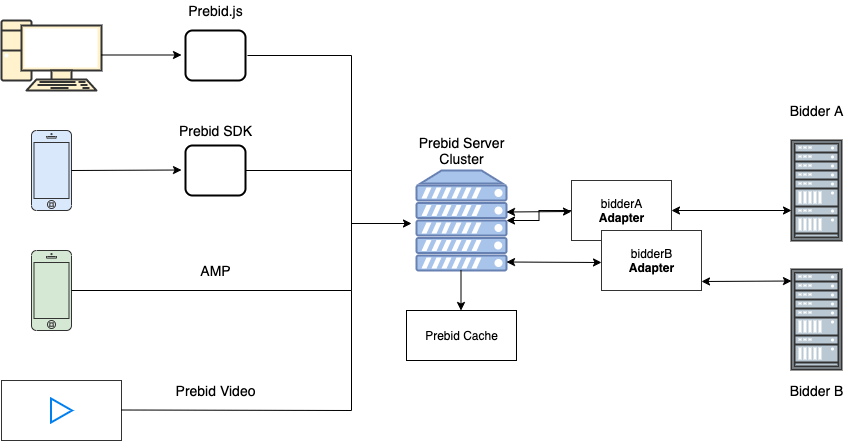
Fuente: Prebid
Comprender la conexión entre Prebid.js, Prebid server y Prebid adapters
Prebid.js es una parte integral del ecosistema de header bidding y es una conexión clave entre Prebid Server y Prebid adapters.
Básicamente, Prebid.js es una biblioteca del lado del cliente que permite a los editores gestionar socios de demanda (postores) y realizar header bidding directamente desde el navegador.
Los Prebid adapters, por otro lado, son módulos o conectores individuales que traducen solicitudes de oferta y respuestas entre Prebid.js y las API de los socios de demanda, lo que permite que varias fuentes de demanda interactúen de forma estandarizada.
Prebid Server es un componente opcional del lado del servidor que puede funcionar en combinación con Prebid.js para liberar al navegador de una parte del trabajo, gestionando las solicitudes de pujas y las respuestas en el lado del servidor. De este modo, es posible reducir la latencia y mejorar la experiencia del usuario.
Juntos, Prebid.js, Prebid Server y Prebid adapters forman una arquitectura cohesiva y flexible que admite un proceso de header bidding eficiente, transparente y personalizable, lo que permite a los editores maximizar sus ingresos publicitarios.
¿Cómo funciona Prebid?
El principio básico de Prebid o de tecnología Pre-bidding es que, permite a múltiples socios de demanda pujar por el inventario de anuncios de un editor simultáneamente.
Prebid Wrapper permite a los editores aumentar fácilmente la cantidad de postores en sus subastas y automatizar la gestión de sus socios de demanda.
La biblioteca Prebid.js consta de los siguientes componentes: adapters y módulos opcionales que un editor desea utilizar y el código wrapper central.
El proceso de Header Bidding Prebid.js se puede completar en 4 pasos:
- La biblioteca prebid.js (colección de atributos de segmentación) obtiene ofertas y creatividades de los distintos SSPs y ad exchanges, mientras que el tag del ad server en la página se detiene y se limita por un tiempo de espera.
- Prebid.js envía detalles sobre esas ofertas (incluido el precio) a la etiqueta del servidor de anuncios en la página, que los envía como parámetros de cadena de consulta al servidor de anuncios.
- Dentro del límite de tiempo establecido por el editor, el ad server evalúa estas ofertas utilizando factores como el tipo de anuncio, precio base y la estructura del anuncio.
- Prebid.js recibe una señal del ad server que le indica que publique la creatividad ganadora, (en caso de que la haya), en la página web.
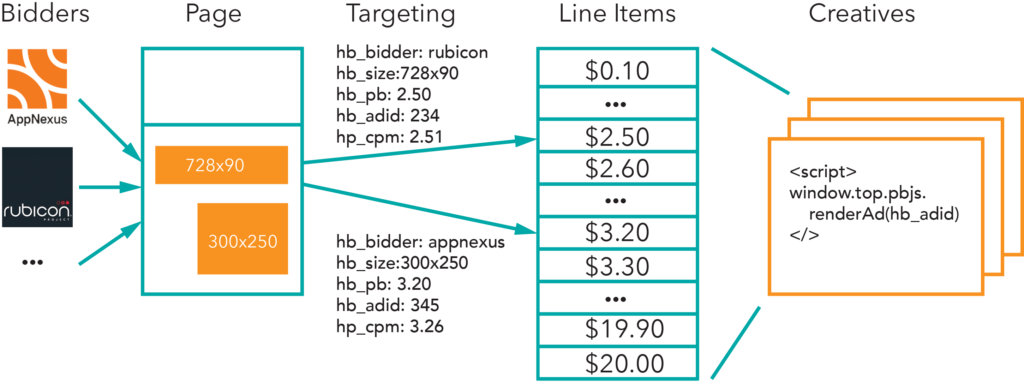
Fuente: Prebid
Prebid vs Waterfall
Tanto las subastas prebid, como waterfall fueron diseñadas para aumentar los ingresos de los editores. Waterfall tiene una desventaja notable: su sistema de subasta es lineal.
Lo que significa que, la primera oferta por encima del precio mínimo gana, a pesar de que otros socios podrían haber pagado más.
Por otro lado, con prebid todas las ofertas se realizan simultáneamente, por lo que gana el mejor postor.
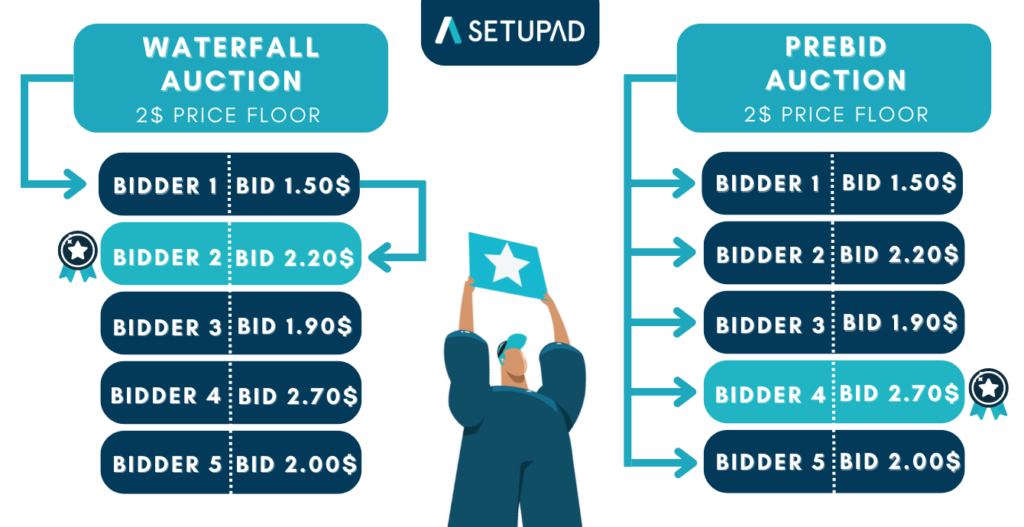
Los editores que dependen de waterfall programmatic pueden perder sus ingresos potenciales, en comparación con la tecnología de header bidding.
Por lo tanto, cambiar de waterfall programmatic a una solución avanzada de header bidding es la mejor solución para un editor.
Prebid vs Header Bidding
Prebid es la solución líder de header bidding, gratuita y de código abierto, disponible para cualquier editor que desee implementar header bidding.
Header Bidding es un método de publicidad digital en el que las solicitudes de anuncios se envían simultáneamente a múltiples plataformas publicitarias o postores. Permite una mayor competencia entre compradores potenciales, lo que genera mayores ingresos para los editores.
Prebid facilita la implementación de header bidding. Sirve como un conjunto de herramientas que permite a los editores configurar su sistema de header bidding sin comenzar desde cero.
La contribución de Prebid fue crucial para hacer que header bidding fuera más popular, ya que ofrece un marco flexible y abierto, sobre el cual otras empresas pueden construir sus propias soluciones especializadas. Este enfoque cooperativo dio como resultado un ecosistema más dinámico y variado de soluciones de header bidding.

Beneficios de Prebid
Los editores pueden aprovechar 6 beneficios principales al utilizar productos prebid para mejorar su experiencia de header bidding, como por ejemplo:
- Permite que cualquiera contribuya o revise el código, ya que la colección de soluciones disponible es gratuita y de código abierto.
- Proporciona la colección más extensa de adaptadores de header bidding funcionales.
- Con un wrapper prebid, header bidding es más fluido, lo que se traduce en tiempos de respuesta más rápidos, menor latencia y una experiencia de usuario mejorada.
- Prebid Server permite realizar subastas más rápidamente y con más socios.
- Admite varios canales (mobile, web, app) y opciones de formato (display, vídeo, native).
- Los editores pueden utilizar los exhaustivos análisis de prebid para obtener datos valiosos sobre el rendimiento de sus anuncios y sobre cómo mejorar sus campañas.
¿Cómo implementar Prebid.js?
Aquí hay 6 pasos para implementar prebid.js:
- Para mostrar anuncios en la página, agrega el código prebid.js a tu página. Este código realiza una subasta entre unas pocas fuentes de demanda.
- Prebid.js llama a cada fuente de demanda simultáneamente.
- Las fuentes de demanda envían ofertas de regreso a la página.
- Estas ofertas se reenvían a su adserver a través de prebid.js.
- El adserver selecciona la oferta ganadora para publicarla en función de las líneas de pedido orientadas a keywords que cumplen con los rangos de precios.
- La página muestra la creatividad de la oferta ganadora.
Puede consultar el siguiente ejemplo para obtener una explicación más detallada de cómo funciona header bidding.
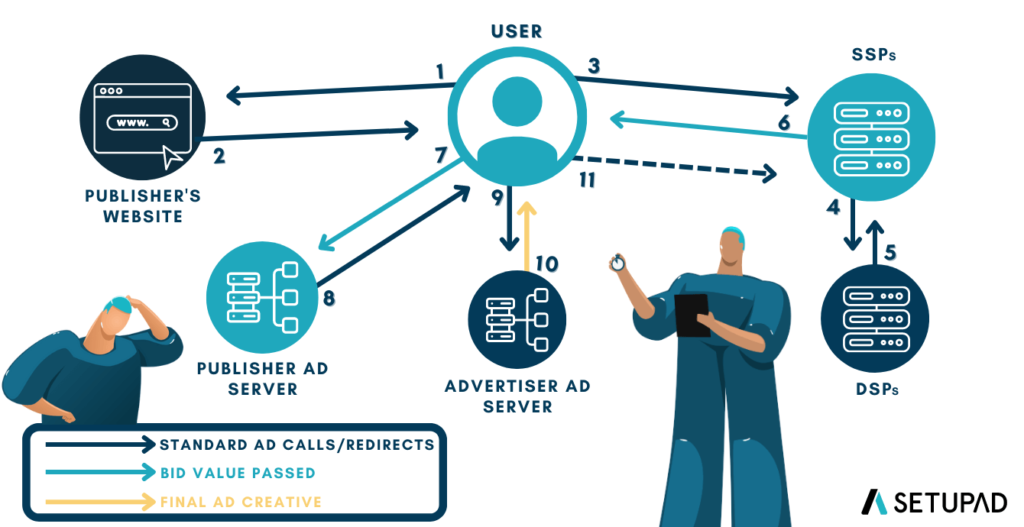
Problemas frecuentes con la implementación de Prebid.js
Muchos editores prefieren asociarse con una plataforma de header bidding como Setupad, principalmente debido a las dificultades relacionadas con la implementación y el mantenimiento de prebid.js por su cuenta.
El hecho de que prebid.js necesite un equipo de AdOps dedicado para implementarlo y administrarlo de manera eficiente, es uno de los principales desafíos para la mayoría de los editores.
Aquí hay 5 problemas más comunes con la implementación de prebid:
- Desajuste en la granularidad de los precios.Por ejemplo, si sus grupos de precios están configurados con una granularidad de $0.10 pero las líneas de pedido esperan un aumento de $0.50, los precios de oferta como $0.71 o $0.99 no coincidiría con ninguna línea de pedido.
- Manejo de la API de Google. La configuración de líneas de pedido implica estar familiarizado con la API de Google, así como algunos conocimientos bácicos de codificación. Otra razón por la que muchos renuncian a Prebid es que, este requerimiento es particularmente difícil para los editores más pequeños que no cuentan con personal dedicado a la programación.
- La prioridad de las partidas no-prebid es mayor.Incluso con precios de oferta reducidos, las partidas con prepuja no ganarán si tiene partidas de patrocinio activas. Utilice las herramientas de depuración proporcionadas por sus adservers, como Consola para editores de Google, para determinar si las partidas de mayor prioridad están activas.
- Configuración de análisis en tiempo real. Para maximizar sus ingresos, los editores necesitan tener acceso a datos exhaustivos sobre sus creatividades. Por desgracia, puede resultar difícil desarrollar un sistema compatible con todos los socios de demanda para recopilar y evaluar estos datos. Recurrir a un servicio externo es la opción ideal para los editores que carecen del personal necesario para gestionarlo internamente.
- Aunque las ofertas regresan, no se muestran anuncios. Verificar los precios de oferta. Si son bajos y se reducen a $0 debido a la configuración de granularidad de precios, su adserver decida no mostrarlos.
Setupad Prebid
Setupad Prebid es un software prebid.js personalizado y optimizado para Google.
La tecnología está preconfigurada, se proporcionan adapters para conectarse con las cuentas GAM y SSP de los editores existentes, y los ingresos publicitarios se pagan directamente al editor a través de los socios de demanda.
Básicamente, se trata de una tecnología para editores que desean obtener acceso a una potente solución híbrida de header bidding y ampliar su funcionalidad de configuración actual a subastas del lado del servidor a través de Prebid Server, Google Open Bidding y Amazon Transparent Ad Marketplace.
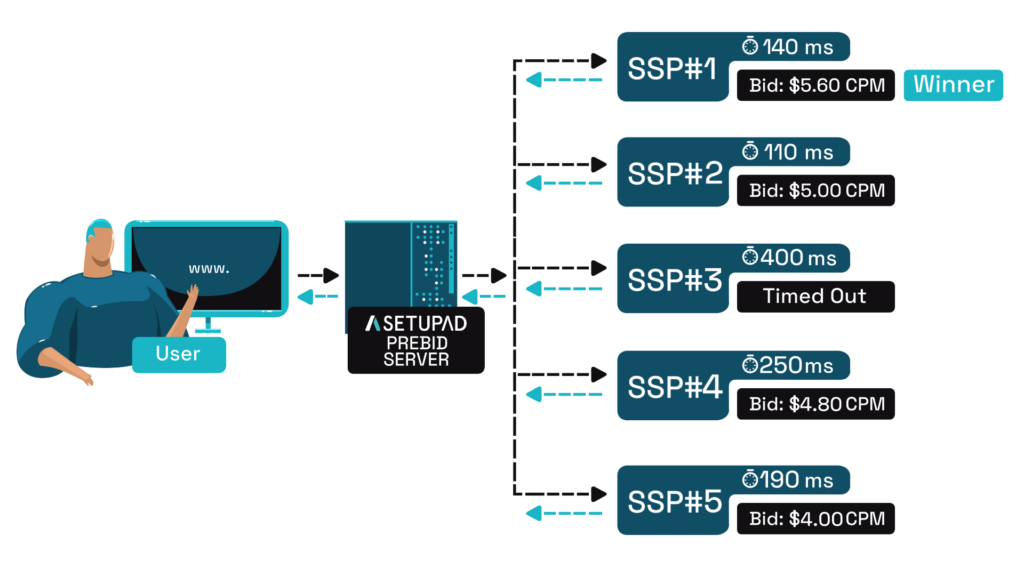
Con este servicio de software, los editores reciben una solución de monetización directa para optimizar sus campañas directas con socios de demanda programática, como AdX de Google, SSP, DSP y Ofertas.
Todas las campañas y ofertas programáticas compiten en la misma subasta de header bidding, lo que aumenta los ingresos publicitarios de los editores.
¿Por qué utilizar Prebid.js Header Bidding Wrapper de Setupad?
wrapper de header bidding de Setupad se crea utilizando prebid.js y está optimizado para una integración fluida en el código fuente de un sitio web o en el ad server del editor (como GAM).
La solución basada en Tags recopila ofertas del cliente y de conexiones client-side y server side para mostrar los anuncios programáticos ganadores.
Para terminar
Header bidding es difícil de configurar por cuenta propia sin los recursos técnicos necesarios. Además, tendrás que encontrar demanda para tu inventario (SSPs), lo que puede ser un obstáculo considerable para los pequeños editores, ya que muchos SSPs grandes no aprobarán un sitio con menos de 100 millones de impresiones mensuales.
Por lo tanto, la mayoría de los editores optan por asociarse con un socio confiable de header bidding.
Setupad tiene numerosas conexiones server-side, incluido un Prebid server, Google Open Bidding y Amazon Transparent Ad Marketplace (TAM). Sin mencionar una amplia variedad de formatos publicitarios, un panel completo para revisar todos los datos e informes, y una atención al cliente rápida y receptiva.
¡Setupad hace todo el trabajo técnico mientras tú ganas más! Regístrate hoy!


